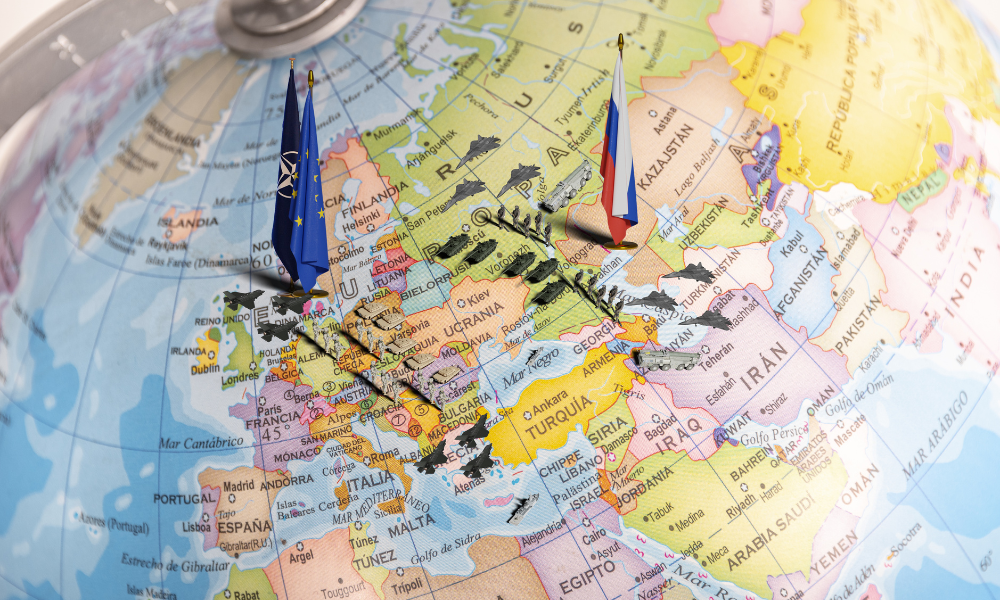
Russia’s full-blown invasion of Ukraine has reaffirmed Nato as the cornerstone of Europe’s defense and forced leaders of the security alliance to rethink how they face down Moscow in a return to cold war doctrine.
Four announcements — a goal of a sevenfold increase in Nato forces on high alert, the first permanent US base on the alliance’s eastern flank, an invitation to Finland and Sweden to join, and a new 10-year guiding strategy that ditches any illusion of partnership with Moscow — amount to a fundamental sharpening of focus for the alliance.“We will enhance our collective defense exercises to be prepared for high-intensity and multi-domain operations and ensure reinforcement of any ally on short notice,” Nato leaders said in a joint declaration. “This will help to prevent any aggression against Nato territory by denying any potential adversary success in meeting its objectives.”
The so-called “tripwire” strategy adopted by Nato after Russia’s 2014 annexation of Crimea — small battle groups pre-positioned on the alliance’s eastern flank to trigger a more muscular response but without themselves provoking Moscow — has been cast aside.
Malcolm Chalmers, deputy director of the Royal United Services Institute, a defense think-tank in London, said Nato was “back on a cold war mission” with its primary purpose being “deterrence of Russia”.
Estonia’s prime minister Kaja Kallas laid out the new security challenge in vivid terms last week when she warned the alliance her nation would be “wiped off the map” by a Russian attack unless Nato drastically beefed up its defense of its new members in eastern Europe.
On Wednesday she hailed the “fundamental shift” in Nato’s force posture. “We have agreed on Nato’s modern forward defense that would deny our adversary any opportunity for aggression,” she wrote on Twitter from Madrid. “Work must immediately start to translate this collective political will into reality.”
Rose Gottemoeller, former deputy secretary-general of Nato, said the alliance had agreed to a “big renewal of its readiness to fight if need be”.
“There needs to be a more efficient and effective way of deterring Russia and that means being able and ready to defend territory from the outset.”
Pre-positioning greater combat forces are part of the answer. The US said it would send a further 5,000 troops to Romania and the UK 1,000 to Estonia. But the more significant change, Gottemoeller said, was Nato’s commitment to vastly increase the number of rapidly deployable troops, underpinned by planning processes to ensure that each country’s forces were sent to the right place and assigned the right task.
A planned increase to 300,000 troops trained and prepared to respond to an attack within 30 days represents a return to the alliance’s cold war doctrine, where its military commanders would have detailed plans for defending against attacks on specific territories with specific troops and weapons.
A new US army corps headquarters permanently stationed in Poland will support the readiness effort, which is set to be implemented next year after Nato collates enough troop pledges from allies.
The deployment is a coup for the Polish government, which has urged successive US administrations to establish a permanent base in the country.
“We have been waiting for a long time for this news,” said Poland’s president Andrzej Duda. “It strengthens our safety a lot . . . in the difficult situation that we are in.”
Analysts said the new troop deployments bolstered the long-held view in Poland and the Baltic states that Nato needed to do more to secure the region.
“The US along with our European allies are really trying to figure out how to not only reassure Nato’s eastern allies but at the same time make sure that our forward presence and deterrence measures in that region are strong enough that Putin is sufficiently and successfully deterred,” said Rachel Rizzo, a senior fellow at the Atlantic Council.
The base is important because it will lend permanent planning, training, and command and control capabilities to ensure the 300,000 high-alert force commitment becomes a reality, Gottemoeller said, rather than involve a large deployment of combat troops.
For that reason, US officials said, it would not breach the 1997 agreement between Nato and Russia not to permanently station new combat forces on the territory of former communist bloc countries. Similarly, the US and allied deployments to Romania and the Baltic states will be rotational and not permanent.
The US is deploying two extra destroyers to its naval base at Rota, southern Spain, to beef up its presence in the Mediterranean, and two squadrons of F-35 fighter jets to the UK, where they will be designated for northern Europe patrols, defense, and deterrence.
Ben Hodges, former commander of US armed forces in Europe, said President Biden’s announcement on Wednesday would bring the number of American troops in the region up to between 100,000 and 120,000.
After the second world war, US forces in Europe peaked during the cold war at about 300,000.
“We don’t need the numbers that we did during the cold war but the sign of commitment and having the real capability, especially on things like air and missile defense, headquarters, logistics, these sorts of capabilities are very important,” Hodges said. “This is a significant increase, and it’s a muscle too.”
Hot Topics
Why AMD Stock Fell Over 5% Today
Which Stock Is A Better Buy: Netflix Or DocuSign?
Wall St Week Ahead Bruised U.S. Stock Investors Brace For More Pain In Second Half Of 2022
Ben Wallace, UK defense secretary, said the US deployments were an expression of its “continued commitment to reassuring allies that as you move from tripwire to more pointed defense, that there will be a more permanent presence of US forces in Europe”. Source: Financial Times